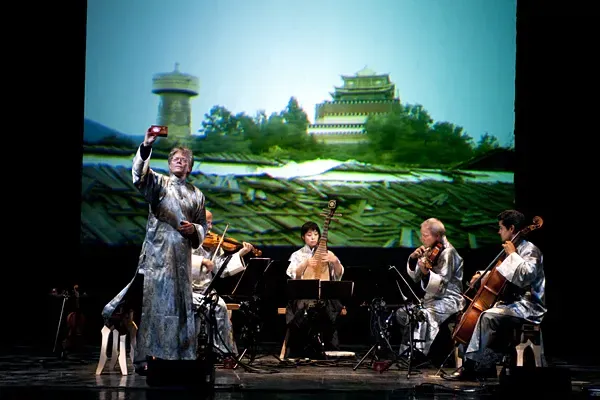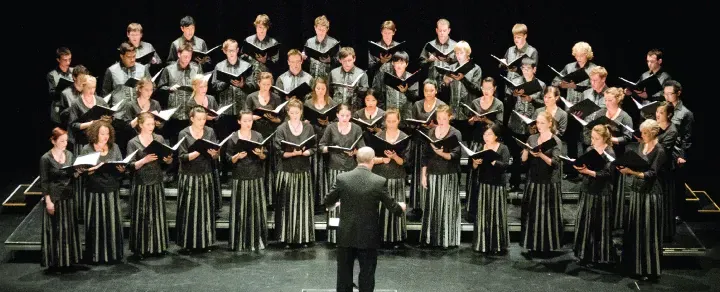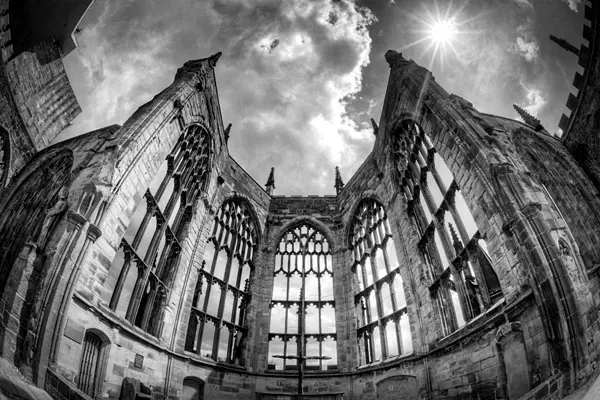Music box medley

Claire Cowan returns from her musical travels to report back on Kronos Quartet with Wu Man, Little Britten - NZ Youth Choir and Voices NZ, Jack Body's Songs and Dances of Desire, Britten's War Requiem and NZ Trio Convergence.
* * *
The Auckland Arts Festival is over, and as usual, there were so many concerts and so little time...
The festival started with the rockstars of classical music - Kronos Quartet, with Pipa player Wu Man. We heard Tan Dun's masterful Ghost Opera - played by the quartet it was written for. It featured spoken word (and shouted 'yowwws') from all players, snippets of Bach, giant glowing fishbowls (minus the fish) into which players dipped hands and bowed gongs to eerie effect. Also what looked like a giant roll of loo paper suspended from the heavens, which Wu Man shook around like a thunder sheet, and a gorgeously delicate Pipa performance - where complex melodies dip and curve under Wu Man's skillful hand.
The second half was Wu Man's own composition/collaboration with the Quartet - featuring video, radios, singing and moments of humour and poignant sadness. It basically charted very quickly the entire history of China and various musical influences along the way, ending, predictably with the westernization of China, and the influence of technology. Whilst this ended with an awesome electric Pipa solo (Wu man can really shred!) and the unpacking of 50 or so battery powered moving flashing toys, we were left feeling somewhat spoon-fed. The composition and performance of both works felt a little disempowering for the audience, leaving little up to the imagination of the listener, but instead theatrically enhancing everything almost to the point of pantomime.
I also made it to Little Britten, a choral concert at Parnell Cathedral, featuring Benjamin Britten's choral works performed by NZ Youth Choir and Voices NZ under Karen Grylls. I am always so impressed by these top performing choirs in NZ, their attention to fine tuning, stage etiquette, vocal blending and articulation is admirable for a largely young choir. Britten's works ranged from quiet and contemplative to rich harmonic language with difficult pitch juxtapositions (impeccably executed) and some fine singing from several vocal soloists, the soprano Pepe Becker standing out from the rest. Our attention lagged in the rather dull organ solos in the middle of the program, and towards the end I was a bit mellowed out with all the vocal tones blending into one (and despite spitting consonants I still couldn't pick up most words because of the huge reverb.) I guess that's the thing about choral concerts, when the choir's technique is virtually flawless, and even the most dissonant harmony sounds heavenly, it is somewhat difficult to keep our ears at attention.
Now a more in depth review of the three concerts that stood out as most interesting for me.
Jack Body's Songs and Dances of Desire
This show is a devised project by APO composer in residence Jack Body, inspired by (and featuring an actor recreating her) Carmen Rupe, (Trevor Rupe) a famous drag queen from a coffee lounge Welly in the 1970's. Trevor was a public figure and was a champion for equal rights and civil liberties. Apparently quite a force to reckon with.
I went into the concert not knowing what to expect. The information on the festival website was sparse, but further research promised a 'flamboyant' performance work featuring opera soloists, NZ's only countertenor, a drag performance and Spanish guitar. Great! Sounded promising. I was expecting a cross between a K'rd drag act and a Bizet opera..Wildly outrageous costumes, lip-syncing? Fake nails and feathers? Mixed with bold brass fanfares, slinky strings and flaming hot fluttering flutes? I was also promised male nudity. This is very unusual in an orchestral concert. Very. I was looking forward to seeing the usual loyal APO crowd raise an eyebrow. Or two.
What was delivered partly fulfilled my expectations. There was indeed flamboyant costumes with a home-made aesthetic, lovingly realized by Warwick Broadhead, (I loved the final costume head adornment made from a shower soap rack.) There was also some lip-syncing, feathers and fake nails. There was some ridiculously high brass. There was also male nudity. But, I missed it somehow. I think it's because he was swinging from the rafters which I completely couldn't see from my cheap seat in the back of the stalls. Once I twigged something was actually happening I left my seat to go have a squiz, we were delightfully showered with twirling paper flowers being dropped from the ceiling. I was later informed he was, briefly, underwearless. I'm not sure what the point of that was, but it's always good to get the punters along yes?
The soloists were all fantastic. Anna Pierard, despite suffering from a nasty throat infection, still charmed us with her low dulcet tones, singing in Spanish, whilst Mere Boynton singing in Te Reo had us entranced with her soulful and powerful delivery of some (at times, frankly raunchy yet comic) lyrics. Countertenor Xiao Ma, dressed in a white suit not dissimilar to a sort of Chinese Elvis outfit, delivered a performance far from his costume-sake's sultry tones. His voice was clear, bright and delicate, and he performed some of the traditional Carmen arias by Bizet that Jack had woven into his score.
The orchestration had quite obvious quotations and subtle re-orchestrations of Bizet's "Carmen" opera. Along with the costumes and choreography, it had many cultural influences woven in, including flamenco, Maori waiata, Hawaiian hula, and more middle-eastern sounds. Spanish-style guitarist Norio Sato was an excellent performer, yet seemed a bit overloaded with notes, and lacking the freedom and spontaneity that would usually go hand in hand with traditional flamenco playing. The Hawaiian hula section (although featuring awesomely swaying palm trees puppeteered by somewhat serious stagehands) had a 'beach barbie' vibe, and seemed to drag on for a bit long (pardon the pun), pedantically orchestrating out to Spanish guitar and orchestra what would have sounded better on a simple slide guitar or ukulele.
There were some delightful moments of masterful orchestration with detailed texture and thoughtful percussion and rhythmic flair. There were also some slightly emptier sounding orchestrations where I thought the orchestra were underutilized. The orchestra was expanded to include extra percussion, accordion, guitar and voices.
The drag performance/dance choreography by the gorgeous dancer Jason Moore was a novel visual treat, but unfortunately lacked inspiration. He seemed almost a little bit shy or intimidated by the experience. I don't envy him, he obviously had very big high heels to fill, portraying the legend Carmen Rupe in many changing outfits, from flamenco queen to the sultry veiled belly dancer Salome.
The finale of the show was supposed to be a celebratory party, with balloons dropping from the ceiling and festive drag style cat-walking. But the orchestra sounded weak and flimsily held together - suggesting a lack of rehearsal or lacklustre orchestrating. I left feeling pretty underwhelmed, and almost a bit sorry for the orchestra, who themselves seemed unconvinced by the whole concept. Had more time gone into rehearsing, and tighter artistic/choreographic direction this could have been a much more impressive production of a promising concept.
Britten's War Requiem with APO and NZ Youth Choir
Nothing could be more contrasting to Carmen than Benjamin Britten's giant War Requiem, performed at the town hall with 3 choirs, organ and 3 vocal soloists. Jammed like sardines on the town hall stage and choirs sprawling out into the balconies, the combined forces produced everything from the most powerful wailing fortissimo, to the most whispered angelic singing that only NZ's world class choral groups could produce. Under the skillful direction of Karen Grylls (conductor of Choir of the world), Voice NZ, NZ Youth Choir and AK Chamber Choir plus a children's choir, produced a hauntingly stunning performance all round.
The three vocal soloists - Orla Boylan (Soprano), Timothy Robinson (tenor) and Ivan Ludlow (Baritone) were perfectly matched, and were obviously putting in everything they had to pay homage to Britten's work and his anti-war agenda. They sung with great soulfulness and tenderness - particularly memorable was the vocal duet between the men singing of angels and an extended metaphor of "Death" - composed with beautiful moments of dissonance expertly pitched between the two.
The orchestra and conductor stepped up to perform with great conviction and force - here was music they absolutely believed in. How could we not be moved by the tolling of the bells, skillful brass fanfares erupting from the back of the stage, moments of soloists voices rising above all other orchestral brilliant cacophony. The passion of Britten was alive in the town hall that night. And as the conductor stood silent on the podium after the final notes rang out, the silence in the town hall seemed to be potently alive with the spirit of Britten.
NZ Trio - Convergence
I'm a completely biased fan of these three musicians. Biased because I've had the pleasure of working with them before, and have spent the last month writing a new work for them. But nonetheless, I'm going to spend the next few paragraphs singing their praises for their last concert - Convergence, featuring two NZ works for trio and Taonga Pouro (Maori instruments), and two other works by contemporary composers with distinctly cultural/folk inspired sounds.
The show was performed at the Town Hall Concert Chamber on the last night of the festival, which was theatrically lit with a wash of vibrant color on the back wall. The performers were in semi-darkness and had music stand lamps. I appreciate the effort they made to address visual aspect of their performance, too often overlooked by classical performers. It helped add to the mood and magic of the sounds they created.
As the performers entered the stage, pianist Sarah Watkins helped a frail Richard Nunns (grandaddy and master of Taonga Puoro) onto the stage to loud applause. The program began with Gareth Farr's re-worked Nga Kete e Toru, featuring an extra Taonga puoro player, Horomona Horo. Spellbinding from start to finish, the mix of western instruments with Maori was beautifully crafted - from delicate overtones and whistled notes from Richard's flutes, to subtle pitch bending and gentle harmonics to compliment the unearthly tones of bone flutes, contrasted by rhythmical outbursts from the trio in typical Farr manner.
The next two works on the program from Gao Ping Four sketches and Chen Yi Tibetan tunes. Both of Chinese descent, evoked vivid and lush soundscapes of their native China. Instantly we were transported to the composer's homeland, where we heard evocations of Chinese folk instruments, busy market places, and ethereal cloudscapes (in a beautiful movement of Gao's using only harmonics.) I marvel at the subtle changes to technique each player makes to make their western instruments sound more Asian folk than European classical. It is through their skillful use of articulation, vibrato and bowing that changes the tone completely.
The last work on the program, the world premiere of commissioned Victoria Kelly's Toi Huawera (Suspended Way) was preceded by an insightful video documentary of the trio rehearsing and collaborating with the composer. We gained an insight into her compositional process and the themes and concept behind the finished work. Based on a myth invented by the composer, the structure of the piece was decided by story rather than any sort of imposed musical structure. The piece began with a sort of Maori jaws harp - the player tapping on a stick half held in the mouth and using the mouth as a resonator to change the pitch. The trio joined in with woody sounds, col legno (using the wood of the bow rather than the hair.)
Horomona Horo was fascinating to watch and a skillful musician and performer who seemed very comfortable on stage. The trio imitated and blended in with the Maori instruments, whooping cello pizzicato like a bull-roarer, then husky and low like a blown gourd. As Victoria explained in the video documentary, every sound created on every instrument has a meaning associated with a character from the myth she created. And at the core of the myth is a love story, and an appreciation for our Whakapapa which she thinks of as 'pathways that lead everyone and everything back to the place where we all began." The title is elaborated on with this description "A way to reach the highest level of heaven - sometimes described as a web that hangs down from the heavens..sometimes described as a whirlwind path."
Applied musically, this is a rather beautiful metaphor. As the weaver of the web, Victoria created a rich and delicately complicated tapestry of sound. The ethereal piece had a deeply spiritual and profound appreciation for this concept at the heart of traditional Maori belief system - a system which Kelly notes, is found in western culture, but "articulated differently." Her fascination with this mystery of life and death and ''Te Arai'' (the veil that separates us from our ancestors) is an inspiring place for her to source her sound world. The Taonga Puoro themselves each uniquely possess a spiritual guardian and association with various Atua (Gods) of the materials from which they're made. Being a non-Maori composer, Kelly sought advice and guidance from collaborator and Maori consultant Tim Worrall. It was refreshing to see such a strong, inspiring, and mutually respectful collaboration between all the artists of differing musical and cultural backgrounds. Sonically, it paid off.
The audience would have been spellbound throughout the 20 minute long work, had they not been sitting for an hour by this time, and were starting to get a bit restless. It would have been nice to experience this piece with the fresh ears it deserved. Nonetheless by the end of the show there was no doubt we had witnessed some of NZ's greatest composers and performers at the top of their game. The integrity and skill of both composers and performers was highly admirable, the music fresh and original, and for me, the show was the highlight of the festival.
Overall, I thought that the festival programmed some reliably high quality musical performances - and aside from Dances of Desire, which was original and fresh but messily executed, there was a lack of risk taking with NZ musical talent. I would have liked to see more of NZ's younger classical, jazz and popular artists collaborate together to create something with a younger energy. With talk of yearly Auckland festivals perhaps we won't have to wait too long to see this happen



